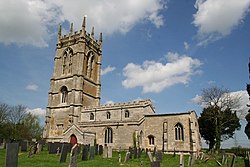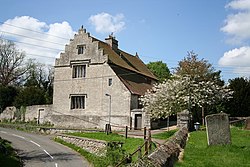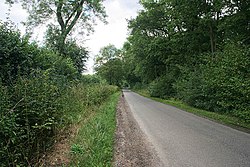Great Ponton
| Great Ponton | |
| Lincolnshire | |
|---|---|
 Church of The Holy Cross, Great Ponton | |
| Location | |
| Grid reference: | SK924302 |
| Location: | 52°51’42"N, -0°37’44"W |
| Data | |
| Population: | 333 (2001[1]) |
| Post town: | Grantham |
| Postcode: | NG33 |
| Dialling code: | 01476 |
| Local Government | |
| Council: | South Kesteven |
| Parliamentary constituency: |
Grantham and Stamford |
Great Ponton is a village and parish in the Kesteven part of Lincolnshire, within the Soke of Grantham, three miles south of Grantham itself. The village sits on the A1 trunk road, which bisects it. The tower of the Church of England parish church is a landmark beside the road. In the 2001 Census, the population was recorded as 333, of whom all were of white ethnic origin and 87 per cent described themselves as Christian. The average age was 40.[1] The population of the civil parish had risen to 379 at the 2011 Census.[2]
History

The village is named in the Domesday Book of 1086 as Magna Pamptune, probably meaning "farmstead by a hill". Some material remains have been found dating back to the Neolithic age. Remains of a mid-Bronze Age round barrow cemetery were discovered between Great Ponton and Sproxton in 1959.[3]
The village church, dedicated to the Holy Cross, dates from the 13th century. Its tall pinnacled tower was added in 1519 at the expense of Anthony Ellys,[4] a wool merchant living in Ellys Manor House, which is nowadays open to the public.[5] The church weather vane depicts a gilded fiddle. The educationalist and school textbook writer Charles Hoole was briefly rector from 1642.[6] Joshua William Brooks, who had been responsible while vicar of St Mary's Church, Nottingham for founding six new churches there, was rector in Great Ponton in 1864–1882.[7]
The Grade I church is among nine listed buildings in the village, six of them residential.[8]
Great Ponton railway station opened in 1853 and closed was on 15 September 1958.
Great Ponton has a limestone quarry.
Geography
Great Ponton is on the A1 approximately three miles south of Grantham. A footbridge provides pedestrian access from the west of the village to the east over the A1.[9] To the east is the River Witham[10] and the East Coast Main Line.

Nearby villages include Stoke Rochford, Stroxton and Little Ponton.
The small hamlet of High Dyke is situated a mile south-east of Great Ponton, where the East Coast Main Line bridges over High Dyke, a stretch of Roman road, part of Ermine Street.
Community
Great Ponton Parish Council meets every two months.[11]
Holy Cross Anglican Church, with St Guthlac's Church at Little Ponton, is in the Colsterworth Group of parishes in the Diocese of Lincoln. The Methodist Dallygate Chapel, built in 1805, closed for worship in 1975.
Great Ponton Church of England Primary School, with a roll of about 70, occupies modern premises in Mill Lane.[12][13]
Great Ponton Village Centre, on Archers Way, is a community centre for social events and functions. The village playing fields are used by local cricket and football clubs.[14][15] The Ponton Plod is an annual long-distance walk and run that raises money for charity. It starts and finishes at the Village Centre.[16]
There is a garage-cum-shop at Ponton Main Service Station on the north-bound carriageway of the A1. The Blue Horse public house facing the south-bound carriageway has been converted into flats.[17]
The village is connected by bus to Grantham, Colsterworth, Woolsthorpe, Skillington, Stainby, Gunby, North Witham and South Witham.[18]
References
- ↑ 1.0 1.1 "Resident Population and Age", Lincolnshire Research Observatory.
- ↑ "Civil Parish population 2011". Neighbourhood Statistics. Office for National Statistics. http://www.neighbourhood.statistics.gov.uk/dissemination/LeadKeyFigures.do?a=7&b=11123952&c=Great+Ponton&d=16&e=62&g=6447344&i=1001x1003x1032x1004&m=0&r=1&s=1463581539641&enc=1. Retrieved 18 May 2016..
- ↑ "Great Ponton Quarry", Archaeology Data Service. Retrieved 18 March 2016.
- ↑ "Holy Cross, Great Ponton", Colsterworth Group of Parishes. Retrieved 18 March 2016.
- ↑ "Ellys Manor House", Ellysmanorhouse.com. Retrieved 25 October 2014.
- ↑ Watt, Francis; "Hoole, Charles" Dictionary of National Biography, 1885–1900, Volume 27. Retrieved 18 March 2016.
- ↑ Bowen, M. W. (1997) The Anglican Church in the Industrialised Town, St. Mary's Parish, Nottingham 1770–1884, October 1997.
- ↑ "Listed Buildings in Great Ponton, South Kesteven, Lincolnshire", British Listed Buildings. Retrieved 18 March 2016.
- ↑ Fareham, Steve; "Footbridge over the A1 at Great Ponton" Geograph, 7 May 2009. Retrieved February 2019.
- ↑ Green Brian; "River Witham valley", Geograph, 17 February 2008. Retrieved February 2019.
- ↑ "Great Ponton Parish Council" Lincolnshire Parish Councils - South Kesteven, Lincolnshire Council. Retrieved 18 March 2016.
- ↑ Great Ponton Primary School, web site. Retrieved 18 March 2016.
- ↑ "C of E Primary School", Geograph, photograph. Retrieved 18 March 2016.
- ↑ "Great Ponton Parish Council", Lincolnshire County Council. Retrieved 18 March 2016.
- ↑ Great Ponton Village Centre web site. Retrieved 18 March 2016.
- ↑ The Ponton Plod web site. Retrieved 18 March 2016.
- ↑ "Blaze in cellar of former pub off the A1 at Great Ponton", The Grantham Journal, 2 July 2015. Retrieved 18 March 2016.
- ↑ "South Witham - Grantham", Traveline, East Midlands. Retrieved 18 March 2016.
Outside links
| ("Wikimedia Commons" has material about Great Ponton) |
- "Picture Gallery", Great Ponton Parish Council
